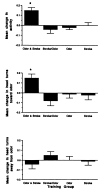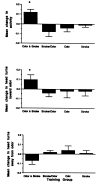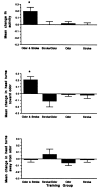Olfactory classical conditioning in neonates
- PMID: 2011429
- PMCID: PMC1952659
Olfactory classical conditioning in neonates
Abstract
One-day-old, awake infants underwent an olfactory classical conditioning procedure to assess associative learning within the olfactory system of newborns. Experimental infants received ten 30-second pairings of a novel olfactory conditioned stimulus (a citrus odor of neutral value) and tactile stimulation provided by stroking as the reinforcing unconditioned stimulus (a stimulus with positive properties). Control babies received only the odor, only the stroking, or the stroking followed by the odor presentation. The next day, all infants, in either the awake or sleep state, were given five 30-second presentations of the odor. Results were analyzed from video tapes scored by an observer unaware of the infants' training condition. The results indicate that only those infants who received the forward pairings of the odor and stroking exhibited conditioned responding (head turning toward the odor) to the citrus odor. The performance of the conditioned response was not affected by the state of the baby during testing, because both awake and sleeping infants exhibited conditioned responses. Furthermore, the expression of the conditioned response was odor specific; a novel floral odor presented during testing did not elicit conditioned responses in the experimental babies. These results suggest that complex associative olfactory learning is seen in newborns within the first 48 hours of life. These baseline findings may serve as normative data against which observation from neonates at risk for neurological sequelae may be compared.
Figures




References
-
- Sullivan RM, Wilson DA, Wong R, Correa A, Leon M. Modified behavioral and olfactory bulb responses to maternal odors in preweanling rats. Dev Brain Res. 1990;53:243–247. - PubMed
-
- Hofer MA, Shair H, Singh P. Evidence that maternal ventral skin substances promote suckling in infant rats. Physiol Behav. 1976;17:131–136. - PubMed
-
- Leon M. Chemical communication in mother-young interactions. In: Vandenbergh JG, editor. Pheromones and Reproduction in Mammals. Academic Press; New York, NY: 1983. pp. 39–77.
-
- Johanson IB, Polefrone JM, Hall WG. Appetitive conditioning in neonatal rats: conditioned ingestive responding to stimuli paired with oral infusions of milk. Dev Psychobiol. 1984;17:357–381. - PubMed
-
- Sullivan RM, Brake SC, Hofer MA, et al. Huddling and independent feeding of neonatal rats is enhanced by a conditioned change in behavioral state. Dev Psychobiol. 1986;19:625–635. - PubMed
Publication types
MeSH terms
Grants and funding
LinkOut - more resources
Full Text Sources
Other Literature Sources
